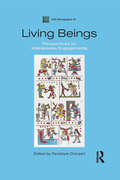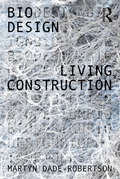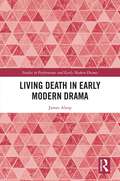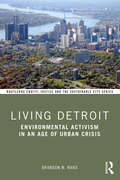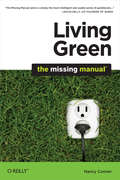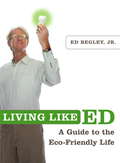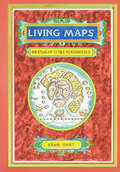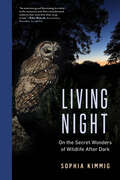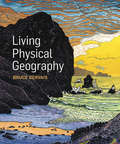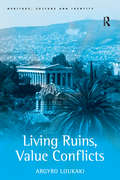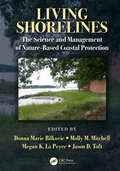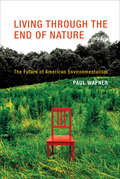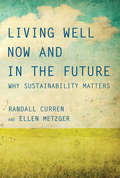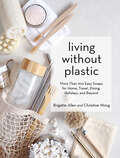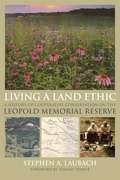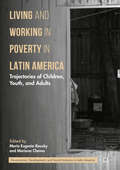- Table View
- List View
Living Beings: Perspectives on Interspecies Engagements (ASA Monographs)
by Penelope DransartLiving Beings examines the vital characteristics of social interactions between living beings, including humans, other animals and trees.Many discussions of such relationships highlight the exceptional qualities of the human members of the category, insisting for instance on their religious beliefs or creativity. In contrast, the international case studies in this volume dissect views based on hierarchical oppositions between human and other living beings. Although human practices may sometimes appear to exist in a realm beyond nature, they are nevertheless subject to the pull of natural forces. These forces may be brought into prominence through a consideration of the interactions between human beings and other inhabitants of the natural world.The interplay in this book between social anthropologists, philosophers and artists cuts across species divisions to examine the experiential dimensions of interspecies engagements. In ethnographically and/or historically contextualized chapters, contributors examine the juxtaposition of human and other living beings in the light of themes such as wildlife safaris, violence, difference, mimicry, simulation, spiritual renewal, dress and language.
Living Construction (Bio Design)
by Martyn Dade-RobertsonModern biotechnologies give us unprecedented control of the fundamental building blocks of life. For designers, across a range of disciplines, emerging fields such as synthetic biology offer the promise of new sustainable materials and structures which may be grown, are self-assembling, are self-healing and adaptable to change. While there is a thriving speculative discourse on the future of design in the age of biotechnology, there are few realized design applications. This book, the first in the Bio Design series, acts as a bridge between design speculation and scientific reality and between contemporary design thinking, in areas such as architecture, product design and fashion design, and the traditional engineering approaches which currently dominate bio technologies. Filled with real examples, Living Construction reveals how living cells construct and transform materials through methods of fabrication and assembly at multiple scales and how designers can utilize these processes.
Living Death in Early Modern Drama (ISSN)
by James AlsopThis book explores historical, socio-political, and metatheatrical readings of a whole host of dying bodies and risen corpses, each part of a long tradition of living death on stage.Just as zombies, ghouls, and the undead in modern media often stand in for present-day concerns, early modern writers frequently imagined living death in complex ways that allowed them to address contemporary anxieties. These include fresh bleeding bodies (and body parts), ghostly Lord Mayors, and dying characters who must carefully choose their last words – or have those words chosen for them by the living. As well as offering fresh interpretations of well-known plays such as Middleton’s The Lady’s Tragedy and Webster’s The White Devil, this innovative study also sheds light on less well-known works such as the anonymous The Tragedy of Locrine, Marston’s Antonio’s Revenge, and Munday’s mayoral pageants Chruso-thriambos and Chrysanaleia. The author demonstrates that wherever characters in early modern drama appear to straddle the line between this world and the next, it is rarely a simple matter of life and death.This book will be of great interest to students, scholars, and practitioners in theatre and performance studies, and cultural and social studies.
Living Detroit: Environmental Activism in an Age of Urban Crisis (Routledge Equity, Justice and the Sustainable City series)
by Brandon M. WardIn Living Detroit, Brandon M. Ward argues that environmentalism in postwar Detroit responded to anxieties over the urban crisis, deindustrialization, and the fate of the city. Tying the diverse stories of environmental activism and politics together is the shared assumption environmental activism could improve their quality of life. Detroit, Michigan, was once the capital of industrial prosperity and the beacon of the American Dream. It has since endured decades of deindustrialization, population loss, and physical decay – in short, it has become the poster child for the urban crisis. This is not a place in which one would expect to discover a history of vibrant expressions of environmentalism; however, in the post-World War II era, while suburban, middle-class homeowners organized into a potent force to protect the natural settings of their communities, in the working-class industrial cities and in the inner city, Detroiters were equally driven by the impulse to conserve their neighborhoods and create a more livable city, pushing back against the forces of deindustrialization and urban crisis. Living Detroit juxtaposes two vibrant and growing fields of American history which often talk past each other: environmentalism and the urban crisis. By putting the two subjects into conversation, we gain a richer understanding of the development of environmental activism and politics after World War II and its relationship to the crisis of America’s cities. This book will be of great interest to students and scholars in environmental, urban, and labor history.
Living Green (Earth in Danger)
by Helen OrmeFrom hybrid cars to energy-efficient light bulbs, the green movement has generated interest in lifestyle changes that help preserve and protect the environment. Living Green pairs easy-to-read text with vibrant photos to engage kids as they explore ways to maintain our natural resources for future generations. A section in the back of the book will inspire young environmentalists by suggesting ways they can help protect their planet.
Living Green: The Missing Manual (Missing Manual)
by Nancy ConnerTaking care of the earth is more important than ever, but the problems we're facing can seem overwhelming. Living Green: The Missing Manual helps make earth-friendly decisions more manageable by narrowing them down to a few simple choices. This all-in-one resource is packed with practical advice on ways you can help the environment by making simple changes in your home routine, work habits, and the way you shop and get around town. You don't have to embark on a radical new lifestyle to make a difference. Living Green: The Missing Manual shows you how small changes can have a big impact. With this book, you will:Learn how to make your home energy efficient and free of toxic chemicalsDiscover how to reduce waste, repurpose and recycle, and do more with lessBuild and remodel earth-friendly homes with new techniques and materialsLearn tips for buying organic food and what it takes to grow your ownGet helpful information on fuel-efficient cars, including hybrid and electric modelsMake your workplace greener and more cost-effective -- from changes at your desk to suggestions for company-wide policiesExplore how to choose renewable energies, such as wind and solar powerThe book also provides you with ways to connect with like-minded people and offers a survey of exciting new green technologies. Learn how you can help the planet with Living Green: The Missing Manual.
Living In Denial: Climate Change, Emotions, and Everyday Life
by Kari Marie NorgaardGlobal warming is the most significant environmental issue of our time, yet public response in Western nations has been meager. Why have so few taken any action? In Living in Denial,sociologist Kari Norgaard searches for answers to this question, drawing on interviews and ethnographic data from her study of "Bygdaby," the fictional name of an actual rural community in western Norway, during the unusually warm winter of 2000-2001. In 2000-2001 the first snowfall came to Bygdaby two months later than usual; ice fishing was impossible; and the skiindustry had to invest substantially in artificial snow-making. Stories in local and national newspapers linked the warm winter explicitly to global warming. Yet residents did not write letters to the editor, pressure politicians, or cut down on use of fossil fuels. Norgaard attributes this lack of response to the phenomenon of socially organized denial, by which information about climate science is known in the abstract but disconnected from political, social, and private life, and sees this as emblematic of how citizens of industrialized countries are responding to global warming. Norgaard finds that for the highly educated and politically savvy residents of Bygdaby, global warming was both common knowledge and unimaginable. Norgaard traces this denial through multiple levels, from emotions to cultural norms to political economy. Herreport from Bygdaby, supplemented by comparisons throughout the book to the United States, tells alarger story behind our paralysis in the face of today's alarming predictions from climate scientists. The hardcover edition does not include a dust jacket.
Living Light: Conserving Bioluminescent Plants and Animals (Orca Wild #14)
by Stephen AitkenBioluminescent animals make their own light to survive. A firefly lights up the night sky, a foxfire mushroom sets the forest floor aglow and sea butterflies shine like beacons deep in the ocean. These glowing species are one of the most spectacular wonders of the natural world, and they are found on land, in the air and in the depths of the ocean. In Living Light, discover how and why bioluminescent creatures glow, and what that special ability can tell scientists about how diseases such as cancer and malaria spread in humans. These light makers are facing threats from the effects of climate change, pollution and loss of habitat, and they need our protection. Young readers will learn how they can shine a light on bioluminescent species and use citizen science to conserve their habitats and keep these creatures glowing into the future. The epub edition of this title is fully accessible.
Living Like Ed: A Guide to the Eco-friendly Life
by Ed Begley Jr.FROM THE PIONEER OF ECO-CONSCIOUS LIVING. A committed environmentalist for more than thirty years, Ed Begley, Jr., has always tried to "live simply so others may simply live." Now, as more and more of us are looking for ways to reduce our impact on the planet and live a better, greener life, Ed shares his experiences on what works, what doesn't--and what will save you money! These are tips for environmentally friendly living that anyone-whether you own or rent, live in a private home or a condo-can try to make a positive change for the environment. From quick fixes to bigger commitments and long-term strategies, Ed will help you make changes in every part of your life. And if you think living green has to mean compromising on aesthetics or comfort, fear not; Ed's wife, Rachelle, insists on style-with a conscience. In Living Like Ed, his environmentalism and her design savvy combine to create a guide to going green that keeps the chic in eco-chic. From recycling more materials than you ever thought possible to composting without raising a stink to buying an electric car, Living Like Ed is packed with ideas-from obvious to ingenious-that will help you live green, live responsibly, live well. Like Ed.
Living Maps: An Atlas of Cities Personified
by Adam DantVenture to twenty-eight cities around the world in this colorfully illustrated collection of maps that take you on a journey through history, culture, and geography.On each page, you’ll visit a different city. And in each city, you’ll explore the metaphorical resonance between the physical metropolis and its inhabitants, history, and culture. In the hands of a creative cartographer, Manhattan is dissected in an anatomical diagram, the streets of Monaco trace the form of a Picasso nude, and the crisscrossing paths of boats on the Bosphorus become the nerves of Istanbul.Travel as you never have traveled before, and revel in the details that define urban life. By laying bare the bone, muscle, and sinew of twenty-eight cities, these maps reveal the unique spirit of each one and shed light on the strange and marvelous ways in which humans interact with the places they call home.Witty and insightful, this book will capture the imaginations of travelers, map enthusiasts, history buffs, and dreamers.
Living Night: On the Secret Wonders of Wildlife After Dark
by Sophia KimmigNatural darkness isn’t merely a time of day. For countless extraordinary species, it’s home. “An entertaining and illuminating love letter to the mysterious and often misunderstood creatures that come alive when we go to bed—and a call to preserve our precious, shared world.”—Robin Bicknell, award-winning documentary filmmaker, Ice and Fire and Nature’s Cleanup Crew When the sun sets, things start to get interesting among wild animals. Wherever we live, whether in the city or suburbs or country, darkness conjures a hidden world of wildlife that most of us rarely glimpse. Foxes, wolves, and bears prowl while skunks, opossums, and porcupines lurk; fireflies send flashing signals to potential mates; raccoons rummage for food; owls and bats fly overhead. Wildlife biologist Sophia Kimmig is our guide to the startling behaviors of these and many more nocturnal creatures. Introducing us to night’s wild inhabitants, she reveals what life for them is like in this parallel world—how it looks, feels, and smells—and the ingenious ways some creatures thrive after sunset. Living Nighthelps us appreciate how essential darkness is: not just a time but a diverse habitat all to itself—one that we still know too little about, and that we must urgently protect for the benefit of the world’s flora and fauna that depend on the day–night cycle.
Living Physical Geography
by Bruce GervaisBruce Gervais' new text offers a fresh approach to the study of physical geography, combining print and digital media to create a scientifically substantive work that is written for students. Living Physical Geography focuses on human-physical geography interactions, using pedagogical features in the textbook and online to create a modern synthesis of the science of physical geography. Each of the four major parts in Living Physical Geography is identified by energy flows within Earth's physical systems. Additionally, landscape analysis underpins the body of the text. Step-by-step examples are used to illustrate how landforms and systems develop, evolve, and change through time. Living Physical Geography is accompanied by its own dedicated version of W. H. Freeman's breakthrough online course space, LaunchPad. LaunchPad offers acclaimed media content, curated and organized for easy assignability and presented in an intuitive interface that combines power and simplicity. What's in the LaunchPad
Living Physical Geography
by Bruce GervaisThe second edition digital update of Bruce Gervais’ Living Physical Geography offers a fresh approach to the study of physical geography, combining print and digital media to create a scientifically substantive work that is written for students. Living Physical Geography focuses on human-physical geography interactions, using pedagogical features in the textbook and online in Achieve to support a modern synthesis of the science of physical geography. In this, the most student-friendly program in the market, the author Bruce Gervais has conceived of and curated a vast suite of learning assets within the text and online in Achieve. For the digital update, all text was reviewed and updated as needed to provide students and instructors with the most current and relevant discussions and data.
Living Physical Geography Digital Update
by Bruce GervaisLiving Physical Geography 2e Digital Update helps you understand how people change and are changed by Earth’s physical systems, ranging from local stream erosion to global climate change.
Living Roofs in Integrated Urban Water Systems
by Daniel Roehr Elizabeth Fassman-BeckWith the infrastructure to manage storm water threats in cities becoming increasingly expensive to build or repair, the design community needs to look at alternative approaches. Living roofs present an opportunity to compliment ground-level storm water control measures, contributing to a holistic, integrated urban water management system. This book offers tools to plan and design living roofs, in the context of effectively mitigating storm water. Quantitative tools for engineering calculations and qualitative discussion of potential influences and interactions of the design team and assembly elements are addressed.
Living Ruins, Value Conflicts (Heritage, Culture and Identity)
by Argyro LoukakiUsing monuments and ruins by way of illustration, this fascinating book examines the symbolic, ideological, geographical and aesthetic importance of Greek classical iconography for the Western world. It examines how classical Greek monuments are simultaneously perceived as sublime national symbols and as a mythological and archetypal reference against which Western modernism is measured. The book investigates the dialogue this double identity leads to, as well as frequent clashes between ancient (but also later) monuments and their modern urban or regional environment. Living Ruins, Value Conflicts examines the complex historical process of monument restoration and enhancement, and analyses the nexus of changing perceptions, aesthetic visions and formal principles over the past two centuries. The book shows the ways in which archaeology and monumentality affect modern life, the modern aesthetic, our notions of nationhood, of place, of self - and the limits to and possibilities for national development imposed by the need to ensure ruins are kept 'alive'.
Living Shorelines: The Science and Management of Nature-Based Coastal Protection (CRC Marine Science)
by Donna Marie Bilkovic Molly M. Mitchell Megan K. La Peyre Jason D. ToftLiving Shorelines: The Science and Management of Nature-based Coastal Protection compiles, synthesizes and interprets the current state of the knowledge on the science and practice of nature-based shoreline protection. This book will serve as a valuable reference to guide scientists, students, managers, planners, regulators, environmental and engineering consultants, and others engaged in the design and implementation of living shorelines. This volume provides a background and history of living shorelines, understandings on management, policy, and project designs, technical synthesis of the science related to living shorelines including insights from new studies, and the identification of research needs, lessons learned, and perspectives on future guidance. <P><P> <li>Makes recommendations on the correct usage of the term living shorelines <li>Offers guidance for shoreline management in the future <li>Includes lessons learned from the practice of shoreline restoration/conservation <li>Synthesizes regional perspectives to identify strategies for the successful design and implementation of living shorelines <li>Reviews specific design criteria for successful implementation of living shorelines <li>Provides detailed discussions of social, regulatory, scientific and technical considerations to justify and design living shoreline projects <P><P> International perspectives are presented from leading researchers and managers in the East, West and Gulf coasts of the United States, Europe, Canada, and Australia that are working on natural approaches to shoreline management. The broad geographic scope and interdisciplinary nature of contributing authors will help to facilitate dialogue and transfer knowledge among different disciplines and across different regions. This book provides coastal communities with the scientific foundation and practical guidance necessary to implement effective shoreline management that enhances ecosystem services and coastal resilience now and into the future.
Living Through the End of Nature: The Future of American Environmentalism
by Paul WapnerEnvironmentalists have always worked to protect the wildness of nature but now must find a new direction. We have so tamed, colonized, and contaminated the natural world that safeguarding it from humans is no longer an option.
Living Through the End of Nature: The Future of American Environmentalism (The\mit Press Ser.)
by Paul WapnerHow environmentalism can reinvent itself in a postnature age: a proposal for navigating between naive naturalism and technological arrogance.Environmentalists have always worked to protect the wildness of nature but now must find a new direction. We have so tamed, colonized, and contaminated the natural world that safeguarding it from humans is no longer an option. Humanity's imprint is now everywhere and all efforts to “preserve” nature require extensive human intervention. At the same time, we are repeatedly told that there is no such thing as nature itself—only our own conceptions of it. One person's endangered species is another's dinner or source of income. In Living Through the End of Nature, Paul Wapner probes the meaning of environmentalism in a postnature age. Wapner argues that we can neither go back to a preindustrial Elysium nor forward to a technological utopia. He proposes a third way that takes seriously the breached boundary between humans and nature and charts a co-evolutionary path in which environmentalists exploit the tension between naturalism and mastery to build a more sustainable, ecologically vibrant, and socially just world.Beautifully written and thoughtfully argued, Living Through the End of Nature provides a powerful vision for environmentalism's future
Living Under the Threat of Earthquakes: Short and Long-term Management of Earthquake Risks and Damage Prevention in Nepal (Springer Natural Hazards)
by Rameshwar Adhikari Jörn H. Kruhl Uwe E. DorkaThis book addresses earthquakes, with a special focus on the Ghorka earthquake, which struck parts of central Nepal in April 2015. Drawing on this disastrous event, it closely examines various aspects of earthquakes in contributions prepared by international experts. The topics covered include: the geological and geophysical background of seismicity; a detailed inventory of the damage done by the earthquake; effective damage prevention through earthquake-safe buildings and settlements; restoration options for world-heritage buildings; strategies for providing technical and medical relief and, lastly, questions associated with public life and economy in a high-risk seismic zone. Combining perspectives from various fields, the book presents the state of the art in all earthquake-related fields and outlines future approaches to risk identification, damage prevention, and disaster management in all parts of society, administration, and politics in Nepal. Beyond the specific disaster in Nepal, the findings presented here will have broader implications for how societies can best deal with disasters.
Living Well Now and in the Future: Why Sustainability Matters (The\mit Press Ser.)
by Randall Curren Ellen MetzgerA philosopher and a scientist propose that sustainability can be understood as living well together without diminishing opportunity to live well in the future.Most people acknowledge the profound importance of sustainability, but few can define it. We are ethically bound to live sustainably for the sake of future generations, but what does that mean? In this book Randall Curren, a philosopher, and Ellen Metzger, a scientist, clarify normative aspects of sustainability. Combining their perspectives, they propose that sustainability can be understood as the art of living well together without diminishing opportunity to live well in the future.Curren and Metzger lay out the nature and value of sustainability, survey the problems, catalog the obstacles, and identify the kind of efforts needed to overcome them. They formulate an ethic of sustainability with lessons for government, organizations, and individuals, and illustrate key ideas with three case studies. Curren and Metzger put intergenerational justice at the heart of sustainability; discuss the need for fair (as opposed to coercive) terms of cooperation to create norms, institutions, and practices conducive to sustainability; formulate a framework for a fundamental ethic of sustainability derived from core components of common morality; and emphasize the importance of sustainability education. The three illustrative case studies focus on the management of energy, water, and food systems, examining the 2010 Gulf of Mexico oil spill, Australia's National Water Management System, and patterns of food production in the Mekong region of Southeast Asia.
Living Without Plastic: More Than 100 Easy Swaps for Home, Travel, Dining, Holidays, and Beyond
by Christine Wong Brigette Allen“An eye-opening guide on how to lessen one’s dependence on plastics. . . . This is a clarion, convincing wake-up call to the scope of the global plastic problem and what readers can do about it. —Publishers Weekly <P><P>Embrace a plastic-free lifestyle with more than 100 simple, stylish swaps for everything from pens and toothbrushes to disposable bottles and the 5 trillion plastic bags we use—and throw out—every year. Use a natural loofah, not a synthetic sponge Buy milk in glass bottles or make homemade nut milk Opt for a waste-free shampoo bar Skip the printed receipt and opt for an email instead Wrap gifts beautifully with cloth <P><P>Organized into five sections—At Home, Food & Drink, Health & Beauty, On the Go, and Special Occasions—Living Without Plastic is a cover-to-cover collection of doable, difference making solutions, including a 30-Day Plastic Detox Program.
Living a Land Ethic
by Stephen A. LaubachIn 1935, in the midst of relentless drought, Aldo Leopold purchased an abandoned farm along the Wisconsin River near Baraboo, Wisconsin. An old chicken coop, later to become famous as the Leopold "Shack," was the property's only intact structure. The Leopold family embraced this spent farm as a new kind of laboratory-a place to experiment on restoring health to an ailing piece of land. Here, Leopold found inspiration for writing "A Sand County Almanac," his influential book of essays on conservation and ethics. "Living a Land Ethic" chronicles the formation of the 1,600-acre reserve surrounding the Shack. When the Leopold Memorial Reserve was founded in 1967, five neighboring families signed an innovative agreement to jointly care for their properties in ways that honored Aldo Leopold's legacy. In the ensuing years, the Reserve's Coleman and Leopold families formed the Sand County Foundation and the Aldo Leopold Foundation. These organizations have been the primary stewards of the Reserve, carrying on a tradition of ecological restoration and cooperative conservation. Author Stephen A. Laubach draws from the archives of both foundations, including articles of incorporation, correspondence, photos, managers' notes, and interviews to share with readers the Reserve's untold history and its important place in the American conservation movement. "
Living and Working With Snow, Ice and Seasons in the Modern Arctic: Everyday Perspectives (Arctic Encounters)
by Monica Tennberg Hannah Strauss-MazzulloThis book describes everyday practices of life in changing Arctic winter conditions. The authors explore the contemporary and situated outdoor practices in different work settings in Finnish Lapland and investigate how, for example, tourism, reindeer herding, cattle breeding and urban snow management adapt to the physically limiting or enabling features of cold temperatures, snow and ice. The book also highlights individual and societal adjustments to such harsh conditions and their seasonal changes in mobility, including winter cycling, use of snow mobiles and walking with studded shoes. The impact of a warming climate is a great concern for those utilising the enabling qualities of winter weather. The need, then, for continuous adaptation in everyday practices of work and mobility will increase in the future.
Living and Working in Poverty in Latin America: Trajectories of Children, Youth, and Adults (Governance, Development, and Social Inclusion in Latin America)
by María Eugenia Rausky Mariana ChavesThis edited volume studies the complex interrelation of poverty, work, and different stages in the life course, and how it contributes to the permanent existence of poverty and inequality in vulnerable groups in society. Mechanisms of productions and reproduction of these relationships are identified through empirical research carried out in four Latin American countries: Mexico, Argentina, Brazil, and Cuba. This book centers on the experiences of individuals in those less favored social groups who may have suffered structural poverty for decades, or who may have been simply deprived of a basic income to cover their most essential needs.
